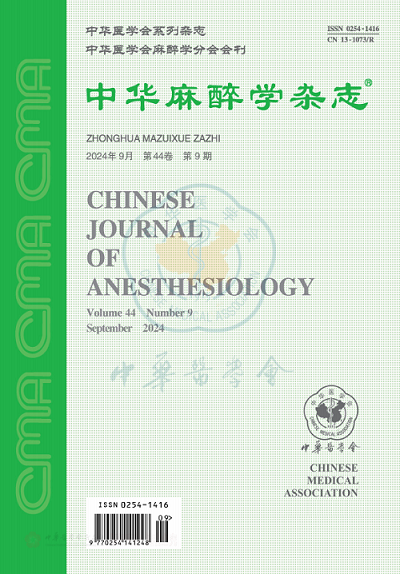Effect of irisin preconditioning on global cerebral ischemia-reperfusion injury in rats
Q4 Medicine
引用次数: 0
Abstract
Objective To evaluate the effect of irisin preconditioning on global cerebral ischemia-reperfusion (I/R) injury in rats. Methods Thirty-six healthy male Sprague-Dawley rats, aged 8-10 weeks, weighing 250-300 g, were divided into 3 groups (n=12 each) using a random number table method: sham operation group (group S), global cerebral I/R group (group I/R) and irisin preconditioning group (group I). Global cerebral I/R was induced by occlusion of bilateral common carotid arteries combined with hypotension (MAP maintained at 35-45 mmHg) in anesthetized rats.At 30 min before ischemia, irisin 10 μg/kg (diluted to 10 μg/ml in normal saline) was intravenously injected in group I, and the equal volume of normal saline was intravenously injected in S and I/R groups.Morris water maze test was performed at day 3 of reperfusion to assess the cognitive function.Rats were sacrificed after the end of morris water maze test, and brains were removed for determination of histopathologic changes in hippocampal CA1 region (using HE staining), neuronal apoptosis in hippocampal CA1 region (Tunel staining), glial fibrillary acidic protein (GFAP) expression (by Western blot), myeloperoxidase (MPO) activity in the hippocampal tissues (by colorimetric assay), and contents of tumor necrosis factor-alpha (TNF-α) and interleukin-1beta (IL-1β) in hippocampal tissues (by enzyme-linked immunosorbent assay). The cell necrosis rate and apoptotic rate were calculated. Results Compared with group S, the escape latency was significantly prolonged on 1-5 days in group I/R and on 1-3 days in group I, the time of staying at 1st quadrant was significantly shortened, the cell necrosis rate and apoptotic rate were increased, the expression of GFAP was up-regulated, and the activity of MPO and contents of TNF-α and IL-1β were increased in I/R and I groups (P<0.05 or 0.01). Compared with group I/R, the escape latency was significantly shortened on 1-5 days, the time of staying at 1st quadrant was prolonged, the cell necrosis rate and apoptotic rate were decreased, the expression of GFAP was down-regulated, and the MPO activity and contents of TNF-α and IL-1β were decreased in group I (P<0.05 or 0.01). Conclusion Irisin preconditioning can reduce the global cerebral I/R injury in rats, and the mechanism may be related to inhibiting activation of astrocytes in hippocampus and reducing inflammatory responses. Key words: Fibronectins; Reperfusion injury; Brain鸢尾素预处理对大鼠全脑缺血再灌注损伤的影响
目的探讨鸢尾素预处理对大鼠全脑缺血再灌注(I/R)损伤的影响。方法36只健康雄性Sprague-Dawley大鼠,年龄8-10周,体重250-300g,采用随机数表法分为3组(每组12只):假手术组(S组)、全脑I/R组(I/R组)和鸢尾素预处理组(I组)。在麻醉大鼠中,通过阻断双侧颈总动脉并结合低血压(MAP维持在35-45mmHg)来诱导全脑I/R。缺血前30min,I组静脉注射鸢尾素10μg/kg(生理盐水稀释至10μg/ml),S组和I/R组静脉注射等量生理盐水。在再灌注第3天进行Morris水迷宫试验以评估认知功能。morris水迷宫试验结束后处死大鼠,取脑测定海马CA1区的组织病理学变化(使用HE染色)、海马CA1区域的神经元凋亡(Tunel染色)、胶质纤维酸性蛋白(GFAP)表达(通过Western印迹)、海马组织中的髓过氧化物酶(MPO)活性(通过比色测定),以及海马组织中肿瘤坏死因子-α(TNF-α)和白细胞介素-β(IL-1β)的含量(通过酶联免疫吸附测定)。计算细胞坏死率和凋亡率。结果与S组相比,I/R组1~5天和I组1~3天的逃逸潜伏期明显延长,停留在第1象限的时间明显缩短,细胞坏死率和凋亡率增加,GFAP表达上调,I/R和I组MPO活性及TNF-,结论Irisin预处理可减轻大鼠全脑I/R损伤,其机制可能与抑制海马星形胶质细胞活化和减轻炎症反应有关。关键词:纤维连接蛋白;再灌注损伤;大脑
本文章由计算机程序翻译,如有差异,请以英文原文为准。
求助全文
约1分钟内获得全文
求助全文

 求助内容:
求助内容: 应助结果提醒方式:
应助结果提醒方式:


